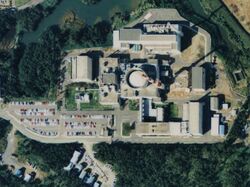Physics:Jōyō (nuclear reactor)

Made based on National Land Image Information (Color Aerial Photographs), Ministry of Land, Infrastructure, Transport and Tourism
Jōyō (常陽) is a test sodium-cooled fast reactor located in Ōarai, Ibaraki, Japan , operated by the Japan Atomic Energy Agency. The name comes from the previous country name of the area around Ibaraki.
It was made with the purpose of doing tests on and advancing the development of that type of reactor, as an irradiation test facility for construction materials. It also does tests with the nuclear fuel as well as activation experiments.
The reactor has gone through 3 different core changes.
- MK-I April 24, 1977 - January 1, 1982 (the power was 50-75 MWt)
- MK-II November 22, 1982 - September 12, 1997. This core surpassed 50,000 hours of operating time with 100 MWt.
- MK-III July 2, 2003–2007 (140-150 MWt).
The current core provides the neutron flux of 4×1015 cm−2s−1 for E>0.1 MeV.
After an incident in 2007, the reactor is suspended for repairing, recovery works were planned to be completed in 2014.
Following the closure of the unsuccessful follow-on fast breeder reactor Monju in 2016, a decision was made to continue research at Jōyō.[1]
On May 24, 2023 the Nuclear Regulation Authority approved a draft report on the safety screening of the reactor which concludes that the countermeasures implemented against sodium fires or core damages meet the new safety standards. The draft is expected to be formally approved after soliciting public comments.[2]
See also
- Monju
- Nuclear power in Japan
References
- ↑ "Japan to continue fast reactor development without Monju". Nuclear Engineering International. 4 October 2016. http://www.neimagazine.com/news/newsjapan-to-continue-fast-reactor-development-without-monju-5023427/.
- ↑ "Japan nuclear regulator likely to approve restart of Joyo reactor". NHK World Japan. 25 May 2023. https://www3.nhk.or.jp/nhkworld/en/news/20230524_17/.
External links
- Official Joyo site (in english)
- Joyo user guide
- T. Soga, W. Itagaki, Y. Kihara, Y. Maeda. Endeavor to improve in-pile testing techniques in the experimental fast reactor Joyo. / In-pile testing and instrumentation for development of generation-IV fuels and materials. Proceedings of a technical meeting held in Halden, Norway, 21–24 August 2012. - IAEA, 2013. - P. 107–122.
- T. Shikama et al. Heavy neutron irradiation test of materials in Joyo instrumented rigs. / In-pile testing and instrumentation for development of generation-IV fuels and materials. Proceedings of a technical meeting held in Halden, Norway, 21–24 August 2012. - IAEA, 2013. - P. 165–170.
[ ⚑ ] 36°16′05″N 140°33′15″E / 36.268039°N 140.554093°E
 |

